|

When
we started visiting the desert from Jeddah we probably did
exactly what others have done and organized trips around the
excellent booklet ‘Desert Treks from Jeddah’ by Patricia Barbor.
The experience starts with one-day excursions and then quite
quickly extends to longer overnight camping trips. Probably the
top three trips people like to undertake in western Saudi Arabia
are Madain Saleh,
Wabah Crater
and the Hijaz railway. By the time these have been accomplished
most people will have been in semi mysterious conversations
about ‘the White Volcanoes’. In speaking to people who have been
in Jeddah for 20+ years most can tell you about someone they
know who has been there, ‘but they have left now’.
This is exactly what happened to us and after an internet search
it was reassuring to find out that they were not figments of
imagination: they really do exist. Also early on, it was evident
that people researching the Lava Tubes of Jabal Q’idr (AKA Jebel
Qidr) write many of the articles, and John and Susy Pint are
often at the centre of these.
The White Volcanoes are currently only covered by low resolution
pictures in Google Earth and it seemed that finding a way to get
there would be problematical. There is no clear track leading to
the volcanoes although the internet articles demonstrate that it
is possible. There were two different accounts of the journey;
both approached from the West near Khaybar and both highlighted
that it was a serious challenge.
Importantly, looking at Google Earth it seems clear that
approaching from an easterly direction means that there is about
30 kilometers of problematical lava field to cross as opposed to
60 kms coming from the West. It also has to be bourn in mind
that the track on the ground is over 1.5 times what the
straight-line distance is.
After more research we were lucky to be provided with both the
exact track from the West as well as the exact track from the
East. It transpired that people who have made the journey from
Riyadh have almost always approached from the East. The decision
was made; we would try to approach from the East.
First Visit: Frozen All Night Long
Our
first trip was in the first week end of February 2011. Six cars
set off from Jeddah on Wednesday afternoon at 4.00 pm. The plan
was to travel five and a half hours and find somewhere to camp.
All went perfectly to plan and at 9:30pm we were in a remote
location where we could camp. Yours truly and Steve decided not
to put the tent up and sleep out under the stars. Mistake! The
wind and low temperature meant that our heads were frozen all
night long. Next morning every one was up early and the only
talk was all about how cold it was, how little sleep had been
achieved and the danger for Thursday night because we would be
another 1,000m higher.
Petroglyphs over 7,000 Years Old
The journey to the volcanoes turned out to be straightforward
using this route. There were no punctures and no real need for
taking two spare tires (which was the advice for the route from
the west). On the way we were approached by a Bedu who kept
referring to ‘kitab’; it was only clear that he wanted us to
follow him and we did. He led us to a particular spot where
there was a great piece of rock art depicting a man, which we
have since been told by a specialist at the Riyadh Museum is
7,000 to 9,000 years old.
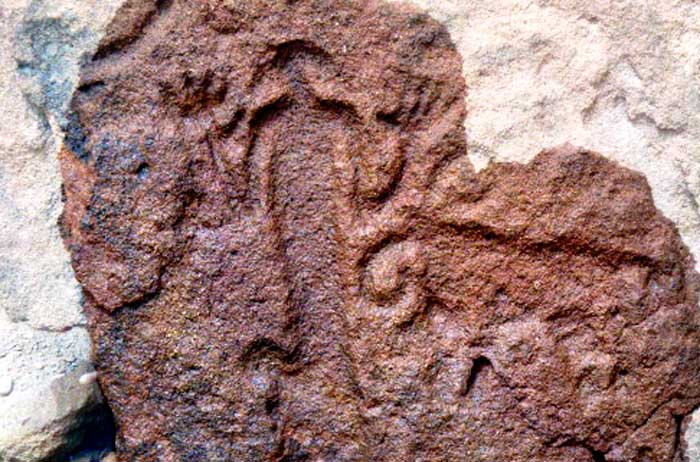
rock art reflecting a human figure
We arrived at the volcano area at 10:00 am and toured the
general area both for sightseeing and with the aim of finding a
good camp site. The latter was resolved when we found a small
sheltered wadi on the eastern edge of Jabal Abayadh (AKA Jebel
Abyad). Once we set up camp we set off to climb Jabal Baitha (Bayda)
which was relatively easy, bearing in mind that the road goes
some way up the side and a good path leads up from there.
Perhaps the climb was 40 minutes and once at the top the views
were wonderful; it included a great view of Jabal Q’idr and the
contrasting black lava that flowed out from its crater. Those
that made it will, in the same breath, also tell you that the
cold wind was just as memorable.
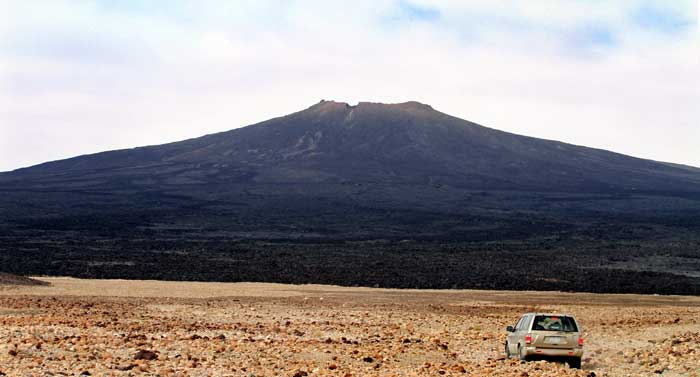
Jabal Q'idr, the
Black Volcano, looms in the distance.
Back at the campsite most people wanted to relax and enjoy the
scenery and recount the stories of the past 24 hours, but Steve
and I went out to explore, just a little bit more. As night took
over the temperature dropped, as we knew it would and it was
hard to keep warm even around the campfire. Once the BBQs were
eaten, the campfire chatter did not last long before we all
headed off to bed. Our temperature gauges at 6:30 am told us it
was 1° C.
The journey back on Friday was uneventful and we were back in
Jeddah by 5:00 pm. It is always a relief on the longer drives to
be home before dark. Perhaps it was also on one of the stops for
coffee that we determined that we would return to climb the
memorable and impressive black volcano of Jabal Q’idr.
Trip Two: The Conquest of Q'idr
This
second trip took place in early June 2011 and our group was
again made up of six cars; three were the same from the previous
trip. This time my lovely wife Maureen was with me. She had had
to miss out on the earlier journey because of a visit back to
Europe. We all knew that climbing this volcano would be a longer
ordeal so we had agreed to make it a three-day trip. On Thursday
we travelled up and by 5:00pm we were setting up camp in the
same spot as before. The journey takes 9 hours. Our worry this
time was that the temperature could be too hot; in the event,
the wind and the altitude conspired to make it just perfect.
 On
Friday a group of nine of us set off to try and drive to a spot
that had been identified on Google Earth as getting us to within
two and a half kilometers of the summit. We managed to find
tracks somehow hewn in the lava by Toyota pickups and were
successful in reaching our targeted parking spot. On
Friday a group of nine of us set off to try and drive to a spot
that had been identified on Google Earth as getting us to within
two and a half kilometers of the summit. We managed to find
tracks somehow hewn in the lava by Toyota pickups and were
successful in reaching our targeted parking spot.
Once we started walking it was clear that lady luck was smiling
on us; the walk over the lava was smooth and easy. It was not
long before we came across the lava tubes that we had all read
about in the papers by John and Susy. Had we seen one we would
have been satisfied, but they were everywhere. The majority were
quite small but there were a few that were large and deep;
forming deep caves.
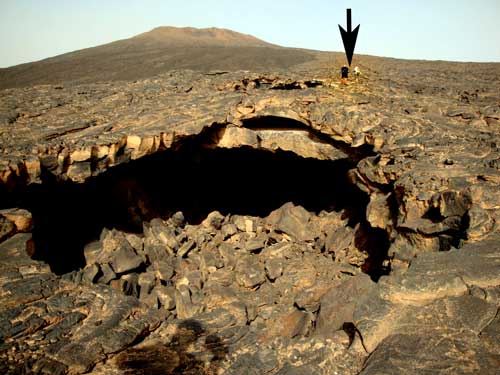 We
were not equipped to explore them although we did venture a few
meters into one and were taken by surprise when doves suddenly
flew past us and out. Thinking about it, this was a perfect
roost, as it stayed cool during the hot summer day. It was
obvious that the doves have been using this spot for decades
because there were two sizeable stalagmites, formed by dove
guano. We
were not equipped to explore them although we did venture a few
meters into one and were taken by surprise when doves suddenly
flew past us and out. Thinking about it, this was a perfect
roost, as it stayed cool during the hot summer day. It was
obvious that the doves have been using this spot for decades
because there were two sizeable stalagmites, formed by dove
guano.
A picture
of the first larger and deeper lava tube we saw. It had two
collapses close to each other. This is the lower one, which I
climbed down into. The upper end had three tubes coming
together; we did not explore it because we had no equipment
(even a torch) which would allow us to do that.
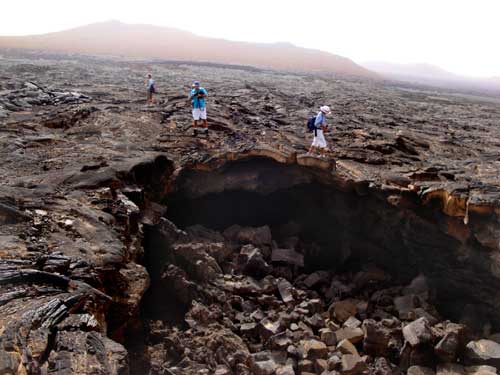
The
upper end of the collapse (but from this angle the three tubes
are not visible)
The
Crater of Q'idr
After
one and a half hours we reached the lip of the crater. The
experience was a little frightening because it arrives so
suddenly and the drop-off, which is sheer, takes everybody by
surprise. More than one person mentioned that they could have
walked over the edge had a warning had not been given by someone
in front.
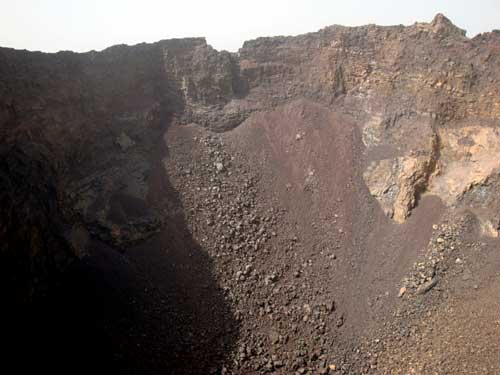
By
1:00 pm we were back at the campsite and met up with the three
who had not made the climb. Mark
Hardaker,
who had volunteered to stay behind for security reasons, had
reconciled himself to missing out on the climb. This would have
been a pity and so I offered to make the climb again; this he
quickly accepted. We followed the same route up and down and my
guess is that I will be amongst the few that have climbed Jabal
Q’idr twice in one day.
When we arrived back at camp we found out that Jonathan and
Philip had climbed Jabal Abyadh in the afternoon; so in the end
we can recount that members of our party had been at the top of
all three volcanoes during Friday. In the evening Nick, Jonathan
and Grant went out to see if we could get the car to the top of
Jabal Baitha. The answer is that there is a car track to the top
on the southern side of the crater which gets to the top; but we
failed to make the steep gradient and had to undertake a tricky
reverse down the scree slope.
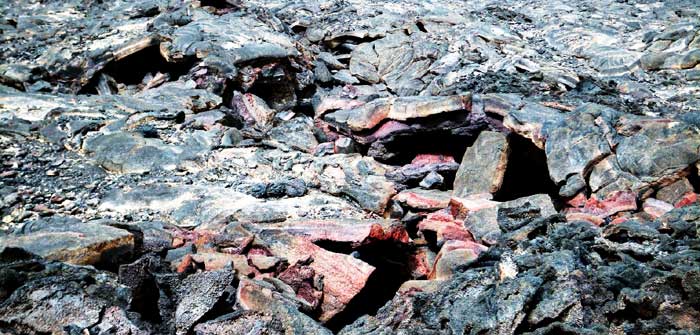
Some
of the landscape we saw on the way down Jabal Q'idr
Round
the camp fire later in the evening we conjectured that it has to
be possible for someone who is reasonably fit to climb all three
volcanoes in one day. The feedback was that getting to the top
of Jabal Abyadh is the toughest of all and would need to be
undertaken first – perhaps a challenge for another day.
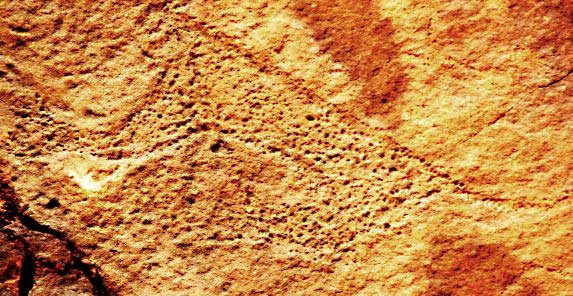 Cheetah
on the Rock Cheetah
on the Rock
The
return journey saw us split into two convoys of three cars
because one group had to be back in Jeddah early. Our three cars
went looking for the rock art we had seen before and got more
than we bargained for. In the same area we found a wonderful
petroglyph of a cheetah, which is not unique in Saudi Arabia but
is still quite rare.
On the
same rock Diana pointed out what looked like a fish and we all
agreed with her that she had found something special.
Unfortunately the specialist in Riyadh—after seeing the
photos—said that we were not right and that there was no fish.
Shame. After a successful weekend climbing volcanoes and seeing
great rock art, somehow the long journey home seemed short and
sweet. If only I had not reversed my car into one of the only
telephone poles in the desert it would have also been
uneventful.
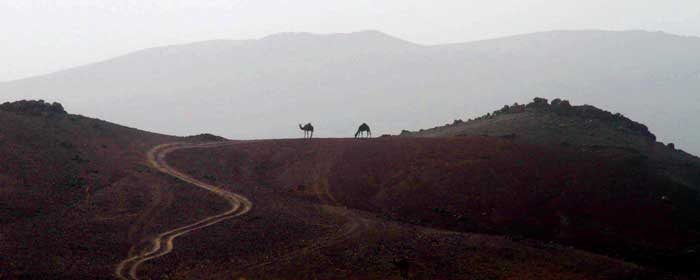
We bid farewell to Harrat Khaybar, with camels on the horizon.
The
area of the White Volcanoes is both beautiful and special. Like
all of the desert areas of Saudi, this wonderful locality can
easily be spoiled if we as visitors do not respect our
environment. Two years ago one of my favorite spots was a gorge
formed of huge pristine basalt crystals; they rivaled those of
Giant’s Causeway (without the sea and view of Scotland). Today
they are daubed with graffiti, painted on with spray paint. It
is so depressing to see and the whole gorge can no longer be
even classified as an attraction. My plea to everyone who
travels though these magnificent lands, especially if you do go
to the White Volcanoes, is to go out of your way to ‘leave only
footprints and take only photographs’.
Grant
Scroggie
Jeddah, Saudi Arabia
6/16/11 6:27 PM
|

